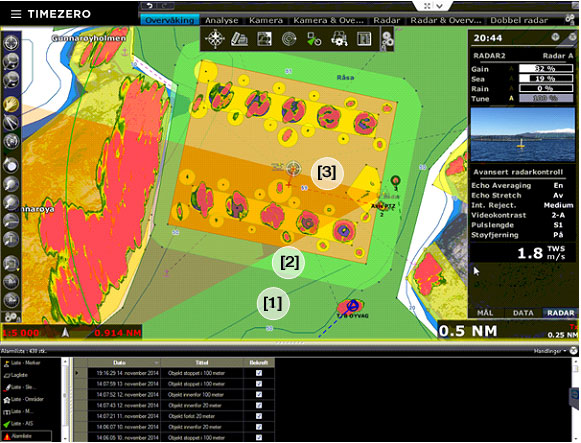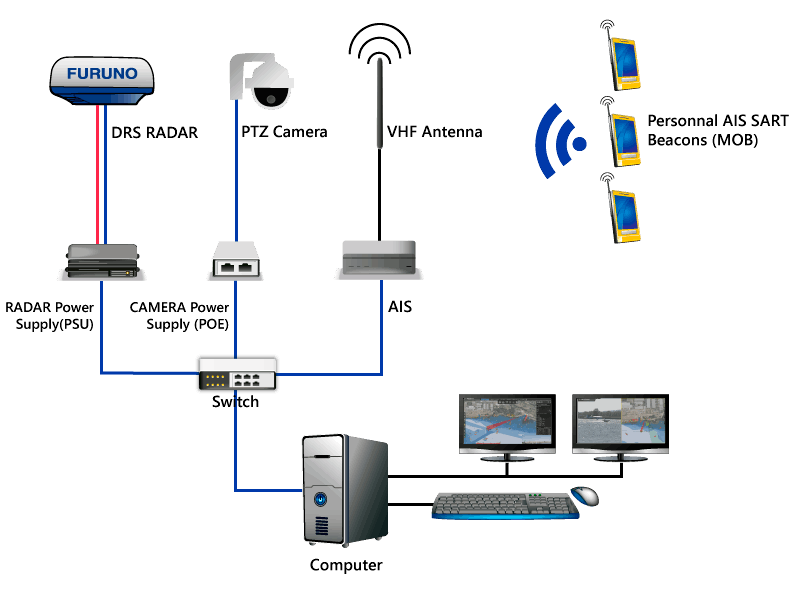Main concerns of fish farms
Employee safety
The safety of employees on fish farms is of course, very important. Unfortunately, it is not unknown for employees to fall into water or to require aid on these sites. Particularly at night, visibility can be low and it is therefore paramount to have a system in place that allows constant surveillance in real-time, as well as the possibility to track and find anyone in danger in order to bring them back to safety.
Theft/Poaching
Depending on the location, theft and poaching can pose a great threat to fish farms. If unprepared, farms can find themselves defenseless against theft which could have severe business repercussions. In the long run, it is certainly preferable to invest in a system that allows you to safe-guard your business against this type of problem.
An example of this occurred in the River Wye in Britain. Between 2009 and 2011, the number of wild salmon dropped by 57%, largely due to illegal poaching. The poached fish was stolen and then sold on the black market. (Source: www.independent.co.uk)
Monitor nearby Traffic
Even in areas where theft and poaching are not a threat, it is very important for the fish farm operator to monitor nearby traffic. A security perimeter has to be established to prevent vessels getting untangled in the fish farm lines and nets. Recreational fishermen might also be tempted to fish near the farm and might accidentally hook a fish inside the farm causing net damage.
The solutions offered by TZ Coastal Monitoring

TZ Coastal Monitoring includes a range of features that are perfectly-adapted to fish farming.
As we have mentioned above, the safety of farm employees is one of the main risks involved in fishing. To combat this, TZ Coastal Monitoring offers several safety features including integration with thermal cameras. These cameras can be controlled directly from the software system and the user can quickly lock-on and track certain targets, such as a man in the water. The advantage of integrating thermal cameras with TZ Coastal Monitoring is that objects are clearly visible even in total darkness. People are particularly visible with heat detection cameras.
If employees working on the fish farm are fitted with an AIS SART beacon inside the life jacket, TZ Coastal Monitoring can automatically trigger an alarm when a man falls in the water.
Not only does TZ Coastal Monitoring alert the on-site operator, but it also gives the exact position of the incident on the screen and can be configured to automatically point the camera in that direction.
By using this solution, surveillance is made extremely simple and allows for a virtually instantaneous response to dangerous situations.
Example of application:
Fish farms in Norway are being equipped with TZ Coastal Monitoring. Every employee is wearing an AIS SART beacon that is automatically triggered when a man falls in the water. In such an incident, a local alarm is triggered, then the camera will automatically pan to track the man in the water and an SMS is sent to the fish farm main operating center.
To prevent theft, poaching and monitor nearby traffic, TZ Coastal Monitoring can detect unknown objects approaching the fish farm with precision. ARPA targets can be tracked by the integrated radar(s) which can alert you to possible intruders even when they are still relatively far from the site. Fish Farm operating service vessels can be classified thanks to AIS to prevent those triggering alarms.
Various boundaries can be drawn by the user and set to trigger different behaviors. For example, in the TIMEZERO software screenshot, a green area [1] has been created to automatically acquire and track targets detected by the Radar (ARPA targets).
A second light green area [2] has been drawn to represent the 100 meter safety area. Any vessel that is not fish farm operated will trigger a notification and the camera automatically points in the direction of the target. This allows the operator to identify the type of vessel and react accordingly.
The read area [3] is the forbidden area (20 meter perimeter) that is set to trigger an alarm and optionally send an SMS or email.

Note: Yellow areas are used to exclude Radar detection from the fish cage or buoys.
Installation Diagram Example
The diagram (Fig.1) highlights a typical installation diagram for Fish Farm operation:
One Dome Radar (or small Open Array antenna)
One Camera (visible or thermal camera)
One AIS receiver is used to receive the position of the fish farm's own service vessels and detect AIS SART (man falls in the water)
Multiple Personal AIS SART beacon that are installed inside the safety jacket and that get automatically activated when touching water
One computer that is used by the local operator to monitor activities

Fish Farm Platform - Fig.1
Users
The most important fish species used in fish farming are carp, salmon, tilapia and catfish. TZ Coastal Monitoring is well-suited to all types of aquaculture that require a monitoring and safety solution.
Here are some examples of the different kinds of fish farming methods employed by potential users of our system:
Cage systems
This is a method of placing cages in the water, so that fish are kept in a controlled area. This is commonly used in lakes, ponds or rivers. “Off-shore cultivation” is the term given to cages that are placed in oceans.
Irrigation ditch or pond systems
They require an area of ground that retains water and it is typically lined with bentonite clay. Some of these sites use above-ground irrigation systems while others underground pipes. The fish waste can fertilize adjoining fields.
Composite fish culture
It's a very efficient system in which several different fish species are farmed in the same waters. The types of fish are carefully selected so that they do not compete for the same types of food. For example, bottom feeders are mixed with column and surface feeders. This optimizes the usage of food in the water.
Integrated recycling systems
They are located in greenhouses, and when properly tuned, produce more edible protein per square foot than any other. Algae naturally grows, given the greenhouse environment and the fish feed on this.
Classic fry farming
Also known as the “flow through system” is a method in which fish eggs are grown until they develop into fingerlings or fry. They are then transported via truck to a stream. This method has been used for years, especially for stocking waters with sport fish.



